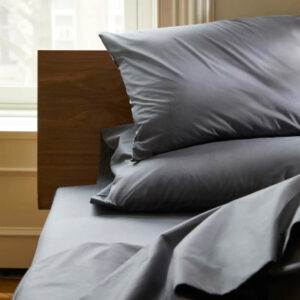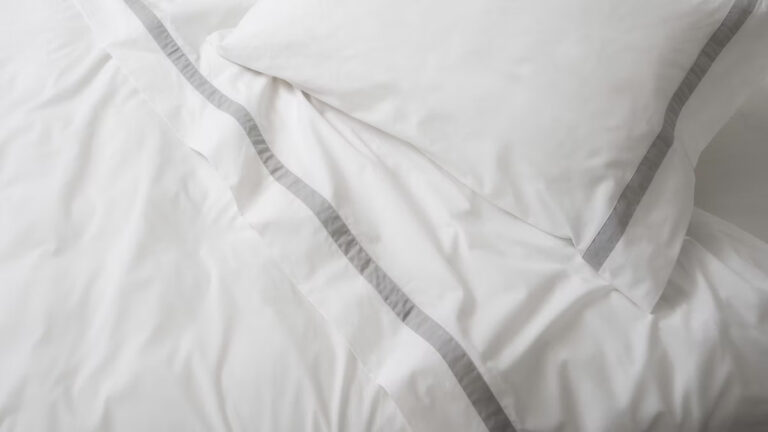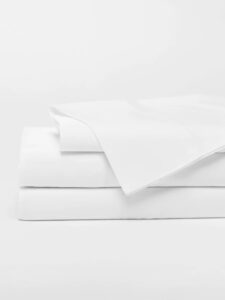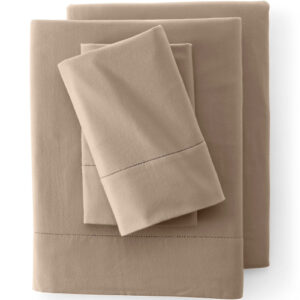We chose the Luxe Sateen Core Sheet Set by Brooklinen as our “Best Overall” because it has high user ratings and the sheets can work for a variety of sleepers. Brooklinen also offers a 365-day return window, which gives you up to a year to decide whether the sheets fit you and your sleeping preferences.
5 Best Sheets of 2025
Key Takeaways
- The Luxe Sateen Core Sheet Set by Brooklinen is our top pick for the best sheets because it’s a high-quality, silky-soft material at an affordable price.
- Cotton is the most common material for bedding, known for its soft feel, durability, and affordability.
- When comparing sheets, always consider whether the material is made from Global Organic Textile Standard (GOTS) or OEKO-TEK certified. This means the textile is either verified organic or has been tested for harmful substances.
If you’re getting eight hours of sleep a night, that means you’re spending one-third of your life sleeping. Anything that takes up that much time is worth investing in. If that isn’t enough of a reason, good sleep is one of the most important contributions to your overall health. It helps your memory and the brain process your experiences—and has even been associated with improved attention, problem-solving, and creativity.
“Bed and bedding comfort is an important aspect of maintaining good sleep hygiene because discomfort makes our sleep light and restless,” said Chelsie Rohrscheib, PhD, a neuroscientist and head sleep expert at the sleep testing and management service Wesper. “People who are uncomfortable during sleep find it difficult to fall asleep and tend to awaken easily.”
To ensure you find the best sheets for your sleep health, we thoroughly researched the materials used in bedding and sheets. Then, we compiled our list of the best sheets to help you decide which is best for your needs.
Our top picks
- Luxe Sateen Core Sheet Set by Brooklinen: Best Overall
- Percale Sheet Set by Saatva: Best for Warm Sleepers
- Bamboo Sheet Set by Cozy Earth: Best for Temperature Regulation
- Deep Pocket Tencel Sheets by Brooklyn Bedding: Best for Sensitive Skin
- Luxe Supima Cotton Flannel Bed Sheet Set by Lands’ End: Best for Cold Sleepers
Why you can trust our review of the best sheets
Our team recommends products and services we feel strongly about to best serve our readers. We’ve spent hundreds of hours evaluating mattresses and adjustable beds as well as more than 50 hours researching bedding and sheets to bring you an accurate review of each product. To make our selection of the best sheets, we:
- Researched a variety of brands and product categories
- Read real reviews from verified customers on trusted third-party sites, including the Better Business Bureau (BBB) and Trustpilot
- Looked at academic studies and reviews to better understand the benefits of types of materials and how sleep is affected based on the sheets you sleep on
- Only chose sheets from Global Organic Textile Standard (GOTS) certified suppliers or ones that are OEKO-TEX® Standard 100 certified. That means every sheet is either produced with certified organic materials or has been tested for harmful substances before sale.
The best sheets of 2025
Table 1 Compare the top-rated sheets, as of 2025
| Sheets | Cost range | Material | Sizes available | Colors available | Learn More |
|---|---|---|---|---|---|
| $159–$229 | 100% long-staple cotton (sateen weave) | Twin/twin XL, full, queen, king, and California king | 16 | Visit Site | |
| $125–$235 | 100% natural long-staple cotton (percale weave) | Twin/twin XL, full, queen, king, split king, and California king | 3 | Visit Site | |
| $339–$469 | 100% premium viscose from bamboo | Twin/twin XL, full, queen, king, split king, and California king | 13 | Visit Site | |
| $169–$229 | 100% TENCEL (lyocell and modal fibers) | Twin/twin XL, full, queen, king, split king, and California king | 3 | Visit Site | |
| $189.95–$259.95 | 100% Supima cotton (flannel weave) | Twin/twin XL, full, queen, king, and California king | 6 | Visit Site |
What to consider when shopping for bed sheets
Choosing bed sheets is a highly personal process. What makes sheets comfortable is based entirely on someone’s preferences. But you should consider a few universal features when shopping for bedding.
Softness: Although some studies show the touch sensation decreases with age, this doesn’t make softness a less considerable factor when shopping for sheets. Materials that are more coarse feel rougher to the touch and can also affect your skin and hair texture. For example, silk’s shiny luster also makes it easier to glide across. That means there’s less friction between your skin or hair and the material. But softer materials usually come at a higher price.
Breathability: This is an important consideration, especially if you run warm while sleeping. Night sweats are relatively common in older adults, so choosing a material that wicks moisture and helps regulate your temperature is also an important consideration. Linen can absorb a significant amount of water in its fibers, which can help lift moisture from your body and keep you from becoming clammy from sweat.
Durability: This might be a higher priority feature if you tend to be restless or move around a lot while sleeping. For example, a sleeper with restless legs syndrome is more likely to wear out the bottom of their sheets with movement throughout the night. Choosing a highly durable material, like cotton, that’s less likely to pill over time, will keep sheets looking nice for longer periods of time.
Another contributing factor to durability is the ratio of material to mattress. The average mattress is 10–12 inches thick (also called the depth of the mattress). If your mattress is thicker than that, you should consider purchasing deep pocket style sheets and accommodate thicknesses up to your mattress size.
For example, if you have a mattress that’s 16 inches in depth, and you use sheets that only go up to 12 inches, the material will stretch too much, making it more vulnerable to tears.
Cost: Cost varies greatly based on the material of the sheets. For example, silk sheets generally cost more than $500, whereas upland cotton sheets usually cost between $50–$100. Of course, some cotton varieties—long-staple and Pima, for example—can cost more than $100 per set. Silk generally carries a high price tag for all pure varieties.
If you’re looking for a silk-like material but want a better price, we suggest looking into a sateen woven cotton. This style gives the luster and feel of silk with the sustainable label of cotton.
Compare common bed sheet materials
Cotton
Cotton sheets are made from the all-natural fibers produced by the cotton plant, making them renewable and biodegradable. It’s one of the most commonly used materials for bed sheets and is easy to maintain and find in stores. Cotton sheets are popular because they’re breathable, generally quite soft, and come in various types.
You can tell the difference between two main types of cotton based on the length and quality of the fibers harvested.
First is long-staple cotton, which only makes up 3% of all cotton in the world. It has long, soft strands and is commonly used for premium bedding. Egyptian and Pima are examples of long-staple cotton. The other is upland cotton, which has shorter fibers and is not quite as soft.
Cotton also comes in different weaves:
- Sateen: This is a luxurious satin-like weave that’s wrinkle-resistant and smooth to the touch and heavier weight. Sateen usually has a visible sheen to it, resembling silk.
- Percale: A tight weave that’s crisp to the touch and lighter weight than flannel or sateen, the lightweight and breathable nature make percale a great material for summer or those living in a warm climate.
- Flannel: While a brushed style weave is generally soft to the touch and has a warm feel, it’s also more vulnerable to pilling over time and isn’t good for those living in a hot climate.
- Twill: With its sturdy diagonal weave that’s thick, highly durable, and wrinkle-resistant, it may not be as soft to the touch as sateen or percale, but the twill weave is often preferred for its beautiful appearance from the diagonal threading.
Linen
Derived from the flax plant, linen is a natural fiber material that’s breathable and hypoallergenic. Linen can absorb moisture and release it into the air, minimizing the dampness as it absorbs. The structure of fibers also makes the material feel cool to the touch as it dries. These qualities make linen a great choice for those who sweat in their sleep.
Bamboo
Bamboo material is best known for being soft, hypoallergenic, and breathable for warm sleepers. Similar to Tencel, bamboo material is made by turning bamboo stalks into pulp. From there the pulp is made into threading that’s spun into textiles and ultimately sheets.
One negative to bamboo textiles is that the process of turning stalks into pulp usually involves harsh chemicals, like sulfuric acid and sodium hydroxide. Another downside is that bamboo sheets are more expensive than cotton, considering the process required to convert it from stalk to textile.
Silk
Silk is made from 100% natural fibers and is known for its incredibly smooth texture, beautiful shine, and cool-to-touch feeling. It is one of the most fragile textiles you can find and, without proper maintenance, can pill and lose its luster. Some sources imply that sleeping on silk materials, specifically pillowcases, can help prevent hair breakage and help skin retain moisture, but more studies are needed to substantiate such claims.
Since most producers of silk still use traditional sericulture methods (cultivating silkworms and extracting raw silk from them) to create the material, many consumers are gravitating toward alternative materials, like cotton sateen, which are considered more ethical and sustainable.
Polyester
Polyester is a synthetic material made from byproducts of natural resources, most commonly petroleum. This makes it a relatively inexpensive material. Unlike cotton or linen, polyester is not considered a breathable or cooling material, so it’s not a great choice for those who get hot or sweaty while sleeping.
Most sheets made with polyester are a blend of materials to help supplement the negative qualities of polyester. For example, microfiber sheets are usually a blend of polyester and other materials, like Tencel or cotton. This helps give softness and breathability to the material.
Tencel
Tencel is the brand name for a durable and shrink-resistant fabric made from eucalyptus wood pulp. While the pulp is technically a natural material, the finished fibers are made by people, so they aren’t “all-natural” like cotton or silk.
The final product is made by dissolving the pulp in chemicals, which is then put through a pressure process to extract long fibers. This process makes Tencel more expensive than other fabrics on the market (like cotton). Tencel is moisture-wicking and breathable, making it a great choice for hot sleepers who tend to sweat.
How we selected the best bed sheets
We spent 50 hours researching, testing, and reading reviews from customers who actually use the products we reviewed to create a list of our top picks. We selected which sheets are the best based on a number of factors, such as:
- Affordability: We looked at which bedding has the greatest value. What are you getting for the price of the bedding?
- Durability: We looked at how long the bedding lasts with nightly usage. How often are people replacing their sheets? Does the material pill easily? Does it become less soft over time? Do the fitted sheets shrink after washing?
- Comfort: We consider how soft the material is, based on hands-on testing and reviews written by long-term users. Are the sheets comfortable for all environments? What happens if you sweat while sleeping? Do the sheets stay moist, or is the moisture wicked?
Bottom line
Sleep, along with diet and exercise, is important to your health, making it certainly worth investing in. Good sleep starts with good sheets. Bedding comes in at a range of prices and in a variety of materials—typically a type of cotton.
The most important thing to consider when purchasing sheets is the material and your specific sleeping preferences. When looking at the price and quality of material, sateen cotton is a strong choice for those who want a soft and high-quality weave that mimics the softness of silk without the expensive cost.

Frequently asked questions about the best sheets
Our top pick for the best sheets is the Luxe Sateen Core Sheet Set by Brooklinen. We chose this set and brand because the company offers a 365-day return window, giving you a whole year to test the bedding and return it if it doesn’t fit your sleeping preferences. Those who purchased the Luxe Sateen Core Sheet Set praise the softness and durability of the material all offered at an affordable price.
Anything between 300–500 is considered a good thread count. It’s usually the case that the higher the count, the better. That means the fibers used to create the textile are finer and softer.
But thread count isn’t necessarily the best indicator of a high-quality product. In fact, a product boasting 1,000 or higher thread count is likely worse quality than that of a lower thread count because the fibers are too broken down and lose softness.
Quality sheets can cost between $150–$300. This price range varies and greatly depends on the bed size and sheet material.
Have questions about this review? Email us at reviewsteam@ncoa.org.
Sources
- O’Connor M. Aging and Sleep: Making Changes for Brain Health. Harvard Health Publishing. March 11, 2019. Found on the internet at https://www.health.harvard.edu/blog/aging-and-sleep-making-changes-for-brain-health-2019031116147
- Wickremaratchi MM and Llewelyn JG. Effects of Ageing on Touch. Postgraduate Medical Journal. May 2006. Found on the internet at https://www.ncbi.nlm.nih.gov/pmc/articles/PMC2563781
- Mold JW, et al. Prevalence and Predictors of Night Sweats, Day Sweats, and Hot Flashes in Older Primary Care Patients: An OKPRN Study. Annals of Family Medicine. September 2004. Found on the internet at https://www.ncbi.nlm.nih.gov/pmc/articles/PMC1466726
- National Institute of Neurological Disorders and Stroke. Restless Legs Syndrome. Found on the internet at https://www.ninds.nih.gov/health-information/disorders/restless-legs-syndrome












